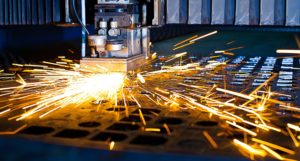The Internet of Things (IoT) has revolutionized the technology industry as it facilitates communication between billions of connected devices and the cloud. While the applications for the IoT are far-reaching from consumer to enterprise markets, one industry particularly positioned to benefit from the widespread adoption of the technology is the manufacturing space. Accenture describes the Industrial Internet of Things, or the IIoT, as a “network of physical objects, systems platforms and applications that contain embedded technology to communication and share intelligence with each other, the external environment and with people.”
The IIoT market, expected to grow at a double-digit compound annual growth rate (CAGR) until at least 2021, has accelerated industrial automation and focused on improving operational efficiency. As it drives productivity and growth over the next decade, Accenture estimates that the IIoT could add a whopping $14.2 trillion to the global economy by 2030, accounting for nearly two-thirds of world output. This new booming “outcome economy” will provide measurable returns, according to Accenture, citing instances such as guaranteed energy savings in commercial buildings and guaranteed crop yields and quality.
IIoT data and analytics insights are valuable in helping organizations innovative and optimize how they use their assets, even those not designed to gather data. Manufacturing executives who have deployed IIoT applications have largely seen clear benefits. According to data from Dell, 53% of manufacturing executives utilizing IIoT reported an improvement in business innovation. The same study found that about half of manufacturing leaders saw an increase in their businesses’ competitive edge, while half also said to have reduced total cost of ownership (TCO). Thirty-three percent of manufacturers who use IIoT reported improved asset utilization, 49% found better process performance and 36% reported lower machine and asset downtime.
Accenture, highlighting the IIoT’s ability to help work become more engaging and productive, indicates that 87% of business leaders say the IIoT will result in the net creation of jobs. As real-time data aids in business analysis, intelligent machines are set to automate workers’ tasks. Employees’ productivity will also be facilitated by new technology such as wearables, creating more jobs and highly flexible organizations.
According to research by Industrial ARC released last year, The IIoT market is expected to boom to surpass $123.89 billion by 2021. The segments with the highest forecasted growth rate within the IIoT space include healthcare and medical devices IIoT, with an expected CAGR of 59.8% over the next four years. Utitilies and other energy sector subgroups such as smart grid penetration follow with an expected CAGR of 39.7% over the same period.
The IIoT market has been the strongest in Europe, where it is forecasted to grow at a CAGR of 22.2% until 2021. In the European region, energy and transport stand alongside manufacturing as the driving IIoT industry segments.
While over the coming years IIoT projects will continue to mature, with a growing number of organizations doubling down on major investments on IIoT projects, challenges will persist as barriers that will block the adoption of IIoT.
According to Dell, there are three main challenges regarding IIoT adoption. The first involves resource constraints as nearly half of all organizations reported budgetary setbacks. Another third reported security and compliance concerns, while 27% were uncertain about ROI, reporting unclear financial benefits and difficult calculating ROI.
In order to optimize IIoT benefits and mitigate risks, organizations are encouraged to build partnerships between OT, IT and business decision makers in order to bring together expertise from different parts of the business. By building a strategy based on concrete ROI analysis, organizations should be more comfortable spending on new projects, starting small and growing incrementally. As the market matures, organizations should also make proper use of the various security tools available to them as they seek to gain insight from the troves of data available due to IIoT advances.
























